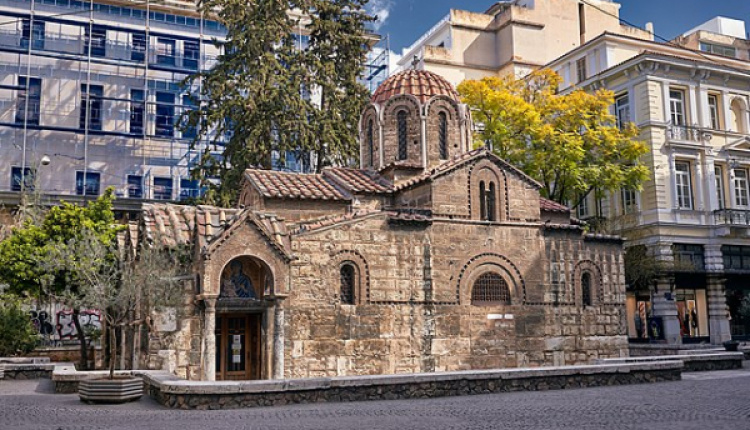Church Of Kapnikarea - One Of Greece's Oldest & Most Historical Churches
- by XpatAthens
- Sunday, 04 December 2022

Located in the center of the modern city of Athens, right in the middle of the high-traffic shopping area of Ermou street, Panagia Kapnikarea is one of the oldest churches in Athens. And, although the church is one of the most widely-known churches in the whole country, frequented by millions of people, both foreigners and locals, its history is not that known.
Let's uncover some of its secrets!
How did it get its name?
In 1689, Athens was firebombed by the Ottomans. Legend has it that although the fire reached the church, the icon of the Virgin Mary survived, but the wooden frame and Mary's face were charred. Kapnikarea comes from the words "kapnos" (smoke in Greek) and "kara" (face, head).
But most people believe the truth behind the church's strange name lies elsewhere. In 802 AD, a tax was imposed on the smoke coming out of the chimneys in Byzantine Athens. Each resident, according to the number of chimneys his house had, paid the corresponding tobacco tax. The tax collector who collected these taxes was called "Kapnikarios," and such a person built the church.
Kapnikarea is a complex tetragonal inscribed cruciform with a dome. Inside, one can find the works of Fotis Kontoglou, created in the mid-20th century. Kapnikarea consists of several parts, with the main part dating back to the 11th century, while the exonarthex and the propylon date back to the 12th century. The one-room chapel of Agia Barbara was built even later.
Why is it located in the middle of the street?
The temple was to be demolished to make way for Ermou Street, according to the new urban planning plans for Athens in 1834. However, King Otto's father, Ludwig King of Bavaria, saved it, and so the street was created around Kapnikarea. Later there were again proposals to demolish it, however, it survived once again thanks to the decision of Theophilos I Vlachopapadopoulos, the Metropolitan bishop of Athens.
This temple could have been destroyed over the years, leaving only its ruins. However, it is still standing and open to visitors. People pass by without realizing that they are next to a monument that has witnessed some of the country's most important historical events.
Originally published in Greek on: youweekly.gr
Let's uncover some of its secrets!
How did it get its name?
In 1689, Athens was firebombed by the Ottomans. Legend has it that although the fire reached the church, the icon of the Virgin Mary survived, but the wooden frame and Mary's face were charred. Kapnikarea comes from the words "kapnos" (smoke in Greek) and "kara" (face, head).
But most people believe the truth behind the church's strange name lies elsewhere. In 802 AD, a tax was imposed on the smoke coming out of the chimneys in Byzantine Athens. Each resident, according to the number of chimneys his house had, paid the corresponding tobacco tax. The tax collector who collected these taxes was called "Kapnikarios," and such a person built the church.
Kapnikarea is a complex tetragonal inscribed cruciform with a dome. Inside, one can find the works of Fotis Kontoglou, created in the mid-20th century. Kapnikarea consists of several parts, with the main part dating back to the 11th century, while the exonarthex and the propylon date back to the 12th century. The one-room chapel of Agia Barbara was built even later.
Why is it located in the middle of the street?
The temple was to be demolished to make way for Ermou Street, according to the new urban planning plans for Athens in 1834. However, King Otto's father, Ludwig King of Bavaria, saved it, and so the street was created around Kapnikarea. Later there were again proposals to demolish it, however, it survived once again thanks to the decision of Theophilos I Vlachopapadopoulos, the Metropolitan bishop of Athens.
This temple could have been destroyed over the years, leaving only its ruins. However, it is still standing and open to visitors. People pass by without realizing that they are next to a monument that has witnessed some of the country's most important historical events.
Originally published in Greek on: youweekly.gr



